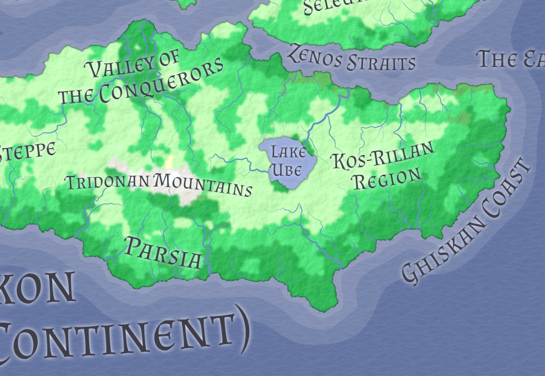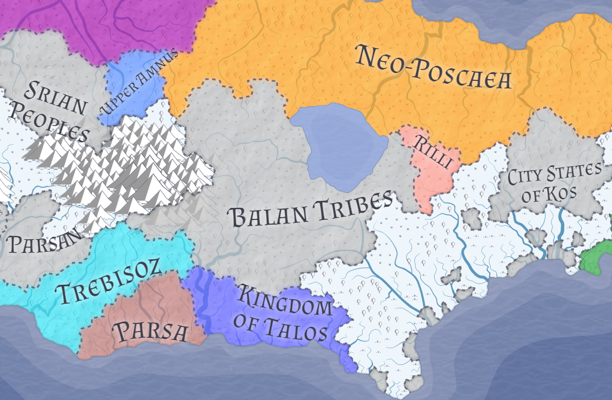Balans and Vendarians
Originating from precursor tribes, the Balans were known for their fervor revolving around Lake Ube and their mass migrations. Balans were typically very physically fit and open to the many changes life brought.
Home Region: Around Lake Ube
Origin: Wild tribespeople, first records unknown
Presence: Waning
Common Religions: Balanism, The True Center Real World Influence: Celtic, Iberian 5e Additions:
Magic Proficiency: Earth Evocation
Non-Magic Proficiency: Athletics
Vendarian Real World Influence: Anatolian Celtic 5e Additions:
Magic Proficiency: Earth Evocation
Non-Magic Proficiency: Religion
Origin: Wild tribespeople, first records unknown
Presence: Waning
Common Religions: Balanism, The True Center Real World Influence: Celtic, Iberian 5e Additions:
Magic Proficiency: Earth Evocation
Non-Magic Proficiency: Athletics
Vendarian Real World Influence: Anatolian Celtic 5e Additions:
Magic Proficiency: Earth Evocation
Non-Magic Proficiency: Religion
Vendarians
Vendarians derived from the Balans primarily, also mixing with the Morosians, and are notable to history for their rivalry with the Trebisozi. Like the Balans, the Vendarians were incredibly fit, but also possessed greater aptitude to tolerate of other cultures.History
Nestled in the heart of eastern Barakon, the Balan people thrived around the majestic Lake Ube. Their connection to the sea hinged on the meandering rivers flowing from Ube. However, the complex geopolitics of the region often thwarted their access to the sea. By 300 BR, the Balans had expanded their civilization over a vast territory, but this golden age was not to last. In the following centuries, they faced invasions from all directions, signaling a period of turmoil and loss. By 05 AR, the tide of fortune turned dramatically against the Balans. The powerful Poscaean invasion reshaped the region's demographics, stripping the Balans of control over half of Lake Ube's coastline. This loss included their sacred capital of Balan, never to be regained. Pushed further inland, the Balans grappled with an increasingly landlocked existence. The burgeoning Kingdoms of Parsa and Talos also clashed with the Balans, further compounding their challenges. Due to unknown political, economic, and environmental strife, the Great Balanian Migration occured around 270 AR. During this period, the Balan people, driven by necessity and ambition, embarked on a massive concentrated movement westward. Their journey led to the dramatic sacking of Zana, a key Talosian city, marking a turning point in regional power dynamics. This migration-turned-invasion was not just a show of strength but a catalyst for change. It laid the foundation for the Abeghenian Regional Federation, led by the dominant Abeghenian tribe. This federation emerged as a new force, reshaping the geopolitical landscape in the wake of the Balanian upheaval.Foederati status and the Vendarians
From the 300s AR onwards, the Balan people gradually forsook the holy Lake Ube and migrated westward. This era was marked by numerous small-scale migrations through the treacherous Tridonan Mountains, leading to their first encounters with the Morosians. Already entangled in their own affairs, the Morosians initially paid little heed to the burgeoning Balanian tribes at their borders. However, recognizing the strategic advantage, the Morosians eventually granted the Balans 'Foederati' status. This move effectively turned the Balans into a buffer against the hostile Kingdom of Trebisoz, exchanging peace and an end to raids for this newfound role. This interaction with the Morosians created a rift within the Balan community, giving rise to two distinct factions: those who aligned with the Morosians and those who opposed this alliance. The pro-Morosian Balans gradually embraced Morosian customs and ideologies, becoming a cultured minority within their own ranks. This group eventually evolved into a distinct culture, known as the Vendarians, characterized by a unique, arguably more egoistic religion called "The True Center of the World." The Vendarians asserted themselves as a formidable state around the 660s AR founded under the leadership of Chief Merta. In a bold move, Merta led his tribes in a surprise attack on the affluent Trebisozi city of Gytria. The conquest of Gytria served as a strategic base, from which Merta launched treacherous assaults against other Balanian tribes, eventually forging the Despotate of Monvia. The Vendarian Despotate of Monvia engaged in numerous wars with Trebisoz, consistently expanding its territory through conflict. However, the tides of war shifted with the arrival of the Daahken Dresnids, who invaded much of Barakon. This external threat forced the Vendarians and Trebisozi into an unlikely alliance, uniting against the relentless Daahken onslaught. Monvia stood as one of the few states resilient enough to withstand the Dresnid tide, in stark contrast to the less fortunate remaining Balanian tribes whose lands and people succumbed alongside most of eastern Barakon. Today, the legacy of the Balan culture endures through the Abeghenian and Gabenian federations, which continue to inhabit the western shores of Lake Ube. This enduring presence is a testament to the resilience and adaptability of the Balan heritage in the face of unrelenting historical upheavals.Traditions
The Balan people are renowned for their creation of various outdoor games and sports. While they may not be the strongest warriors in the land, their exceptional physical fitness and endurance are unmatched. Festivals, predominantly held in the few cities they inhabit, are vibrant celebrations featuring an array of these athletic activities. However, Balanian cities more closely resemble collective campgrounds, where multiple clans establish their bases of operation. The Balanians dedicate their masonry and stonework skills primarily to constructing elaborate, smooth-stone courts for their games. These courts are the most significant markers of Balanian presence, leaving a lasting imprint of their culture wherever they go.Fantasy Additions
The Balanians are largely an orc-dominated civilization. Their biomes range from mountains to jungles around Lake Ube, and they maintain their migratory ways. Due to this, Balanian and Vendarian are the most common lineages of orcs found abroad. Unlike the stereotypical buff, body-built orc, a Balanian or Vendarain orc is rather lean, and moderately muscled. While often conflated with goblins by outsiders, orcs typically hate goblins and giants with a passion. Orcs played a prominent role during significant wars with the goblins worldwide. Some of the most prominent Witchers in Barakon happen to be Balanian orcs. Being landlocked meant that there was minimal opportunity for trade with other nations, and so mixing within the orc population is rather limited to half-breeds who are only found on the fringes of Balanian territory.Remove these ads. Join the Worldbuilders Guild











Comments